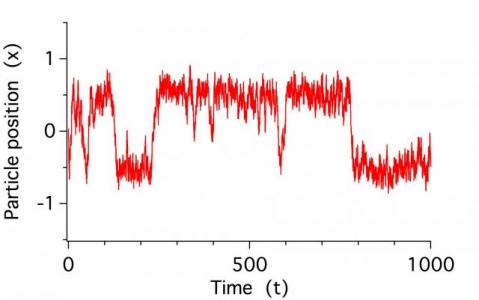
Stochastic ODE: Euler-Maruyama illustrated

bech
Mon, 06/22/2009 - 04:19 pm
If others are interested in stochastic methods, I encourage you to post more examples. This will perhaps persuade the Igor folks to add explicit support for stochastic equations. (While these methods are easy to program in Igor as it stands, they are much slower than what a C-coded version could do. And these calculations tend to require LOTS of iterations.....)
Note that this was developed in 6.10b07, but I see no reason that it won't run in Igor 6.0x.
//________________________________________________________________
function em(M,N,D,Tf) // vector implementation of Euler-Maruyama
variable M,N,D,Tf // M = paths, N = time points
// D = noise strength, Tf = final sim. time
// try M=1, N=1e4, D=0.01, Tf=1000
// SetRandomSeed 0.5 // useful for debugging
variable dt = Tf/N, Xzero = 0 // dt = time step; Xzero = initial condition
wave pars // declare parameter wave
make /o/n=(M,N) dW
dW = sqrt(2*D*dt)*gnoise(1) // M realizations of noise terms dW(t)
Integrate /meth=2 /dim=1 dW /D=W // integral is just sum of dW's
Duplicate /o W, Xem
Xem[][0] = Xzero // initialize all paths
Xem[][1,N] = Xem[p][q-1] + dt*myfunc(pars, (q-1)*dt, Xem[p][q-1]) + dW[p][q-1]
// this is the crucial step for the EM method!
MatrixOp /o Xem0 = row(Xem,0)^t // get a single trajectory to graph
SetScale/P x 0,dt,"", Xem0
killwaves dW,W,Xem // get rid of big waves
end
//________________________________________________________________
Function myfunc(pw,t,x)
wave pw; variable t,x
// t for time-dependent forces; not needed here
variable a=pw[0] // barrier height (try a=0.3)
return a*x - x^3 // force = -dU/dx, U = -a*x^2/2 + x^4/4
End
//________________________________________________________________
Window path_graphs() : Graph
PauseUpdate; Silent 1 // building window...
Display /W=(533,50,1004,389) Xem0
ModifyGraph width=360,height=216
ModifyGraph marker=19
ModifyGraph msize=1
ModifyGraph nticks(bottom)=2
ModifyGraph fSize=18
ModifyGraph manTick(left)={0,1,0,0},manMinor(left)={1,0}
ModifyGraph manTick(bottom)={0,500,0,0},manMinor(bottom)={4,0}
Label left "Particle position (x)"
Label bottom "Time (t)"
SetAxis left -1.5,1.5
ControlBar 42
SetVariable setvar0,pos={67,8},size={214,27},title="barrier height a ",fSize=18
SetVariable setvar0,limits={0,1,0.1},value= pars[0]
EndMacro
function em(M,N,D,Tf) // vector implementation of Euler-Maruyama
variable M,N,D,Tf // M = paths, N = time points
// D = noise strength, Tf = final sim. time
// try M=1, N=1e4, D=0.01, Tf=1000
// SetRandomSeed 0.5 // useful for debugging
variable dt = Tf/N, Xzero = 0 // dt = time step; Xzero = initial condition
wave pars // declare parameter wave
make /o/n=(M,N) dW
dW = sqrt(2*D*dt)*gnoise(1) // M realizations of noise terms dW(t)
Integrate /meth=2 /dim=1 dW /D=W // integral is just sum of dW's
Duplicate /o W, Xem
Xem[][0] = Xzero // initialize all paths
Xem[][1,N] = Xem[p][q-1] + dt*myfunc(pars, (q-1)*dt, Xem[p][q-1]) + dW[p][q-1]
// this is the crucial step for the EM method!
MatrixOp /o Xem0 = row(Xem,0)^t // get a single trajectory to graph
SetScale/P x 0,dt,"", Xem0
killwaves dW,W,Xem // get rid of big waves
end
//________________________________________________________________
Function myfunc(pw,t,x)
wave pw; variable t,x
// t for time-dependent forces; not needed here
variable a=pw[0] // barrier height (try a=0.3)
return a*x - x^3 // force = -dU/dx, U = -a*x^2/2 + x^4/4
End
//________________________________________________________________
Window path_graphs() : Graph
PauseUpdate; Silent 1 // building window...
Display /W=(533,50,1004,389) Xem0
ModifyGraph width=360,height=216
ModifyGraph marker=19
ModifyGraph msize=1
ModifyGraph nticks(bottom)=2
ModifyGraph fSize=18
ModifyGraph manTick(left)={0,1,0,0},manMinor(left)={1,0}
ModifyGraph manTick(bottom)={0,500,0,0},manMinor(bottom)={4,0}
Label left "Particle position (x)"
Label bottom "Time (t)"
SetAxis left -1.5,1.5
ControlBar 42
SetVariable setvar0,pos={67,8},size={214,27},title="barrier height a ",fSize=18
SetVariable setvar0,limits={0,1,0.1},value= pars[0]
EndMacro


Forum

Support

Gallery
Igor Pro 9
Learn More
Igor XOP Toolkit
Learn More
Igor NIDAQ Tools MX
Learn More